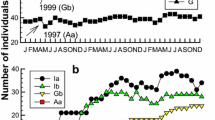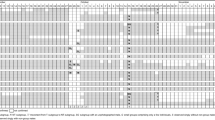Abstract
We analyzed eight group fissions occurring during a 20-year period in three groups of a free-ranging provisioned Barbary macaque population. The founder group fissioned four times within 3.5 years after transfer to the enclosure, indicating that external factors—new environment, more space, absence of other groups—facilitated group fissions. Two groups resulting from these fissions, split twice within 2.5 and 1 years, respectively, many years later. The process of fissioning lasted from a few months to almost 2 years. Fissions were preceded by peripheralization/subgrouping of mainly young adult males (8-10 years old), suggesting that male competition was the primary force for the fissions. The males were joined by middle- to low-ranking but not the lowest-ranking females. The resulting new groups were usually smaller than the groups in which the former α-matriline—old groups—stayed, and they were also more variable in size and sex ratio, suggesting that variable numbers of surplus individuals were expelled during fission. Mean adult sex ratios were similar in both groups after fission, indicating that the competitively superior males in the old groups (groups + α-matriline) could not increase their breeding opportunities. Female kin, even of large matrilinies, almost always stayed together during fission. Natal males strongly preferred to join the old groups, and this preference was most pronounced in juveniles and subadults. Hence, most natal males stayed with maternally related females, i.e., remained true natal males, if the females stayed in old groups. They were separated from female kin, i.e., became seminatal, if the females joined the new groups. These seminatal males did not differ from natal males with respect to matrilineal rank, but they had more female relatives, above all more close relatives (sisters), indicating that avoidance of mating with maternal kin was important for group choice. Despite joining the same group as female kin during fissioning, breeding opportunities of natal males (ratio of unrelated females/male) were not less than that of their seminatal peers, because natal males had fewer female relatives. Only a minority of both groups of males would have done better by joining the alternative group. Paternal relatives were distributed during fission by chance, and loss of patrilinies was therefore much less pronounced. We conclude that the rules governing social relationships among Barbary macaque males are less apt to cope with the high number of males resulting from provisioning, whereas the rules regulating social relationships of females living in a nepotistic, female-bonded society are very robust in this respect.
Similar content being viewed by others
REFERENCES
Altmann, S. A., and Altmann, J. (1979). Demographic constraints on behavior and social organization. In Bernstein, I. S., and Smith, E. O. (eds.), Primate Ecology and Human Origins, Garland, New York, pp. 47–63.
Aureli, F., Das, M., and Veenema, H. C. (1997). Differential kinship effect on reconciliation in three species of macaques (Macaca fascicularis, M. fuscata, and M. sylvanus). J. Comp. Psychol(in press).
Bartecki, U. (1986). The social position of male Barbary macaques (Macaca sylvanus) in a semifree-ranging population. Primates 27: 173–183.
Berard, J.D. (1989). Life histories of male Cayo Santiago macaques. Puerto Rico Hlth. Sci. J. 8: 61–64.
Berenstain; L., and Wade, T. D. (1983). Intrasexual selection and male mating strategies in baboons and macaques. Int. J. Primatol. 4: 201–235.
Chepko-Sade, B. D., and Sade, D. S. (1979). Patterns of group splitting within matrilineal kinship groups: A study of social group structure in Macaca mulatta (Cercopithecidae: Primates). Behav. Ecol. Sociobiol. 5: 67–86.
Cheverud, J. M., Buettner-Janusch, J., and Sade, D. S. (1978). Social group fission and the origin of intergroup genetic differentiation among the rhesus monkeys on Cayo Santiago. Am. J. Phys. Anthropol. 49: 449–456.
Deag, J. M., and Crook, J. H. (1971). Social behavior and “agonistic buffering” in the wild Barbary macaque Macaca sylvana L. Folia Primatol. 15: 183–200.
de Turckheim, G., and Merz, E. (1984). Breeding Barbary macaques in outdoor open enclosures. In Fa, J. E. (ed.), The Barbary Macaque: A Case Study in Conservation, Plenum, New York, pp. 241–261.
de Waal, F. B. M. (1989). Dominance “style” and primate social organization. In Standon, V., and Foley, R. A. (eds.), Comparative Socioecology, Blackwell, Oxford, pp. 243–264.
Dittus, W. P. (1988). Group fission among wild toque macaques as a consequence of female resource competition and environmental stress. Anim. Behav. 36: 1626–1645.
Furuya, Y. (1968). On the fission of troops of Japanese monkeys. I. Five fissions and social changes between 1955 and 1966 in the Gagyusan troop. Primates 9: 323–350.
Furuya, Y. (1969). On the fission of troops of Japanese monkeys. II. General view of troop fission of Japanese monkeys. Primates 10: 47–69.
Grieger, M. (1984). Verhalten alter Berberaffenweibchen (Macaco sylvanus LINNE, 1758). Ein Vergleich zwischen alten Weibchen und ihren adulten Töchtern, Diploma thesis, University of Göttingen, Göttingen.
Heinz, U., and Paul, A. (1994). Feeding-competition in a saturated habitat: behavioral ecology of female Barbary macaques (Macaca sylvanus) at “Affenberg Salem.” Z. Säugetierk. 59 (Suppl.): 19.
Koyama, N. (1970). Changes in dominance rank and division of a wild Japanese monkey troop at Arashiyama. Primates 11: 335–390.
Kuester, J., and Paul, A. (1988). Rank relations of juvenile and subadult natal males of Barbary macaques (Macaca sylvanus) at Affenberg Salem. Folia Primatol. 51: 33–44.
Kuester, J., and Paul, A. (1992). Influence of male competition and female mate choice on male mating success in Barbary macaques (Macaca sylvanus). Behavior 120: 192–217.
Kuester, J., and Paul, A. (1996). Female-female competition and male mate choice in Barbary macaques (Macaca sylvanus). Behavior 133: 763–790.
Kuester, J., Paul, A., and Arnemann, J. (1992). Paternity determination by oligonucleotide DNA fingerprinting in Barbary macaques (Macaca sylvanus). In Martin, R. D., Dixon, A. F., and Wickings, E. J. (eds.), Paternity in Primates: Genetic Tests and Theories, Karger, Basel, pp. 141–154.
Kuester, J., Paul, A., and Arnemann, J. (1994). Kinship, familiarity and mating avoidance in Barbary macaques, Macaca sylvanus. Anim. Behav. 48: 1183–1194.
Kuester, J., Paul, A., and Arnemann, J. (1995). Age-related and individual differences of reproductive success in male and female Barbary macaques (Macaca sylvanus). Primates 36: 461–476.
Missakian, E. A. (1973). The timing of fission among free-ranging rhesus monkeys. Am. J. Phys. Anthropol. 38: 621–624.
Ménard, N., and Vallet, D. (1993). Dynamics of fission in a wild Barbary macaque group (Macaca sylvanus). Int. J. Primatol. 14: 479–500.
Ménard, N., and Vallet, D. (1996). Demography and ecology of Barbary macaques (Macaca sylvanus) in two different habitats. In Fa, J. E., and Lindburg, D. G. (eds.), Evolution and Ecology of Macaque Societies, Cambridge University Press, Cambridge, pp. 106–131.
Moore, J., and Ali, R. (1984). Are dispersal and inbreeding avoidance related? Anim. Behav. 32: 94–112.
Oi, T. (1988). Sociological study on the fission of wild Japanese monkeys (Macaca fuscata yakui) on Yakushima Island. Primates 29: 1–19.
Paul, A. (1989). Determinants of male mating success in a large group of Barbary macaques (Macaca sylvanus) at Affenberg Salem. Primates 30: 461–476.
Paul, A., and Kuester, J. (1985). Intergroup transfer and incest avoidance in semifree-ranging Barbary macaques (Macaca sylvanus) at Salem (FRG). Am. J. Primatol. 8: 317–322.
Paul, A., and Kuester, J. (1987). Dominance, kinship and reproductive value in female Barbary macaques (Macaca sylvanus) at Affenberg Salem. Behav. Ecol. Sociobiol. 21: 323–331.
Paul, A., and Kuester, J. (1988). Life history patterns of semifree-ranging Barbary macaques (Macaca sylvanus) at Affenberg Salem (FRG). In Fa, J. E., and Southwick, C. H. (eds.), Ecology and Behavior of Food-Enhanced Primate Groups, Alan R. Liss, New York, pp. 199–228.
Paul, A., and Kuester, J. (1996). Differential reproduction in male and female Barbary macaques. In Fa, J. E., and Lindburg, D. G. (eds.), Evolution and Ecology of Macaque Societies, Cambridge University Press, Cambridge, pp. 293–317.
Paul, A., Kuester, J., and Arnemann, J. (1996). The sociobiology of male-infant interactions in Barbary macaques, Macaca sylvanus. Anim. Behav. 51: 155–170.
Prud'homme, J. (1991). Group fission in a semifree-ranging population of Barbary macaques (Macaca sylvanus). Primates 32: 9–22.
Prud'homme, J., and Chapais, B. (1993). Rank relations among sisters in semi-free-ranging Barbary macaques (Macaca sylvanus). Int. J. Primatol. 14: 405–420.
Pusey, A. E., and Packer, C. (1987). Dispersal and philopatry. In Smuts, B. B., et al. (eds.), Primate Societies, University of Chicago Pr., Chicago, pp. 250–266.
Robinson, J. G. (1982). Intrasexual competition and mate choice in primates. Am. J. Primatol. Suppl. 1: 131–144.
Ron, T. (1996). Who is responsible for fission in a free-ranging troop of baboons? Ethology 102: 128–133.
Ron, T., Henzi, S. P., and Motro, U. (1994). A new model of fission in primate troops. Anim. Behav. 47: 223–226.
Steuckardt, A. (1991). Der Einfluß der Familiengröβe auf das Beziehungsnetz adulter Berberaffenweibchen (Macaca sylvanus L. 1758), Diploma thesis, University of Göttingen, Göttingen.
Sugiyama, Y. (1960). On the division of a natural troop of Japanese monkeys at Takasakiyama. Primates 2: 109–148.
Taub, D. M. (1980). Female choice and mating strategies among wild Barbary macaques. In Lindburg, D.G. (ed.), The Macaques: Studies in Ecology, Behavior, and Evolution, Van Nostrand Reinhold, New York, pp. 287–344.
Vehrencamp, S. L. (1983). A model for the evolution of despotic versus egalitarian societies. Anim. Behav. 31: 667–682.
Yamagiwa, J. (1985). Socio-sexual factors of troop fission in wild Japanese monkeys (Macaca fuscata yakui) on Yakushima Island, Japan. Primates 26: 105–120.
Author information
Authors and Affiliations
Rights and permissions
About this article
Cite this article
Kuester, J., Paul, A. Group Fission in Barbary Macaques (Macaca sylvanus) at Affenberg Salem. International Journal of Primatology 18, 941–966 (1997). https://doi.org/10.1023/A:1026396113830
Issue Date:
DOI: https://doi.org/10.1023/A:1026396113830




